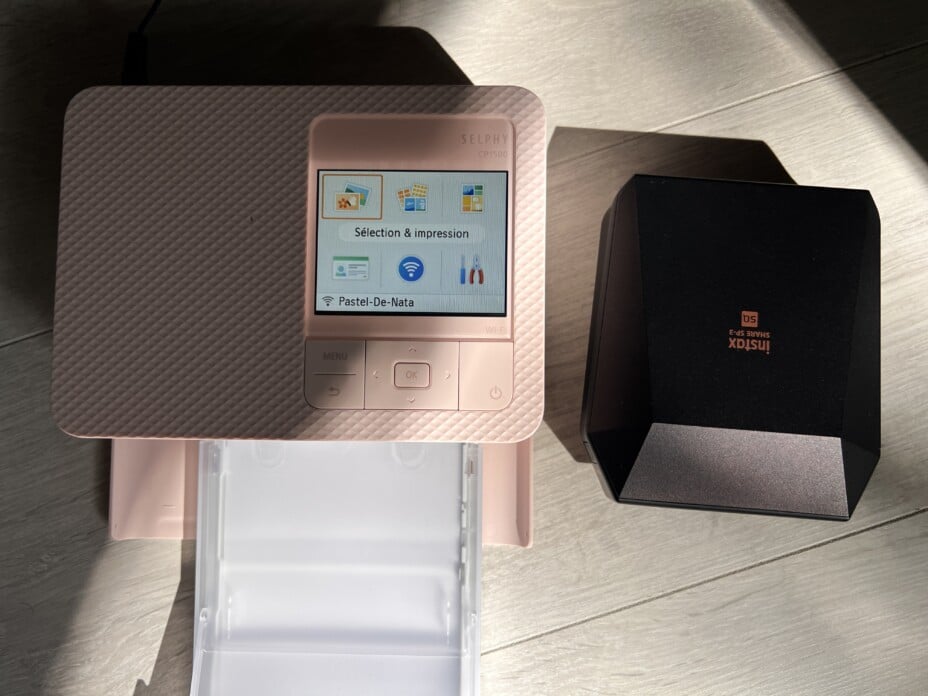Yet another iteration of Canon’s famous mini printer, the Selphy. This CP1500 version succeeds the CP1300 by bringing a hint of speed and a new design. It’s enough to stay ahead of mini printers in 10×15 cm without being revolutionary.
In 2017, it was established that 1000 billion photos had been taken with smartphones. Since then, we no longer count. But it must be even more. Much more.
If taking photos has become as natural a gesture as brushing teeth, printing is a less popular pleasure. However, touching the image, keeping it with you, taking it out later, and displaying it on a refrigerator or a desk is the quintessence of photography.
Three solutions are currently available for mini prints: Fujifilm Instax paper, Zink paper, and dye-sublimation with rollers. In this test, we will discuss the Canon Selphy CP1500 printer and address the quality of the solutions offered in competition and their durability over time. Spoiler: nothing comes close to Canon regarding print quality and accuracy. But that, at the cost of some concessions which are, precisely, not the price.
Printing on the Canon Selphy CP1500
The dye-sublimation printing system already throws off by name and then impresses with quality. The colors are very good, and the accuracy of the print approaches professional solutions. You will obtain more finesse and better color shades by going through laboratories.
Who says the printer says consumables? Canon sells packs in sets of 36 or 108 photos. These packs contain the paper and rollers that deliver the ink. One pack contains exactly enough rolls and paper to print the number indicated on the box.
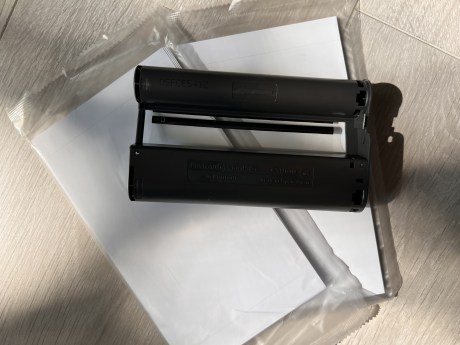
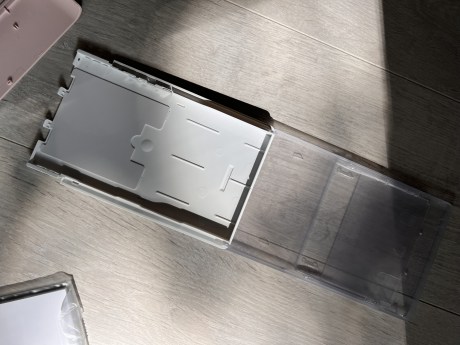
You will have to wait 41 seconds to recover your draw. This is 6 seconds faster than the previous version. If this time seems long, remember that a print has 4 passes: one for each of the three colors (yellow, magenta, cyan), then one for the finish.
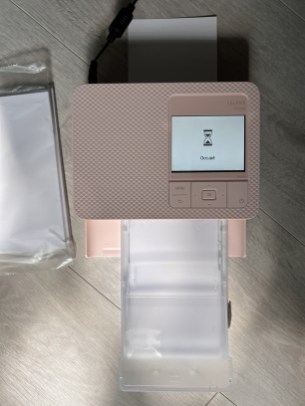
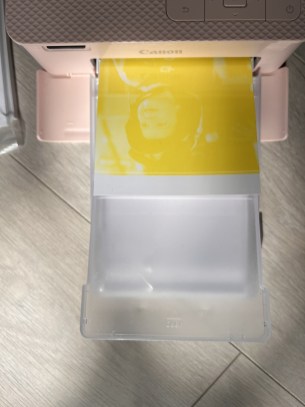
The finishes offered to offer a real plus: the satin finish brings a matt appearance of the most beautiful effect, attenuates the colors, and provides a pleasant touch. Glossy printing is classic but effective for the “ Wow ” effect. Finally, a glossy rendering brings a strange texture: the colors are duller than in the satin rendering.
To these finishes are added filters. The Vivid filter is ideal for enhancing contrast and colors. The slide version is very successful and brings a somewhat vintage rendering, similar to Kodak Portra NC film, for those to whom it evokes something. Neutral delivers realistic and balanced colors. Finally, sepia remains sepia, an outdated and uninteresting style.
Once the photo is available, cut the side edges along the dotted lines for a nice 10×15 cm print (in 3/2 format). This format is the most common on cameras, but smartphones generally have 4/3 format sensors. It will therefore be necessary to reframe.
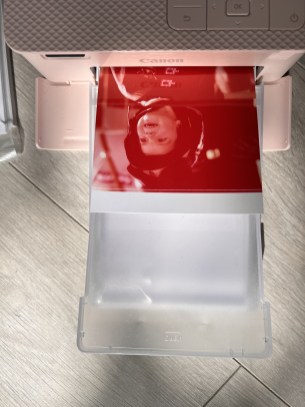
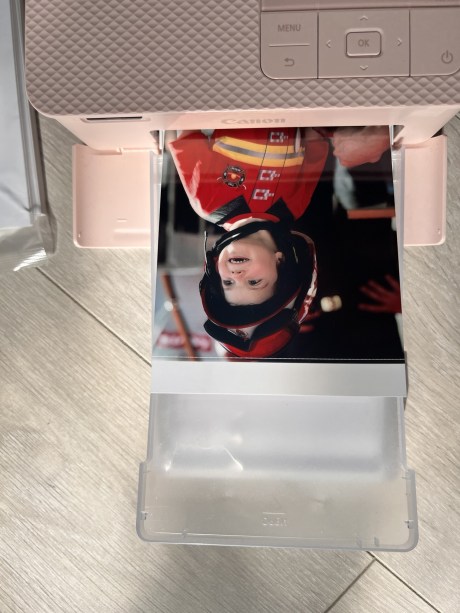
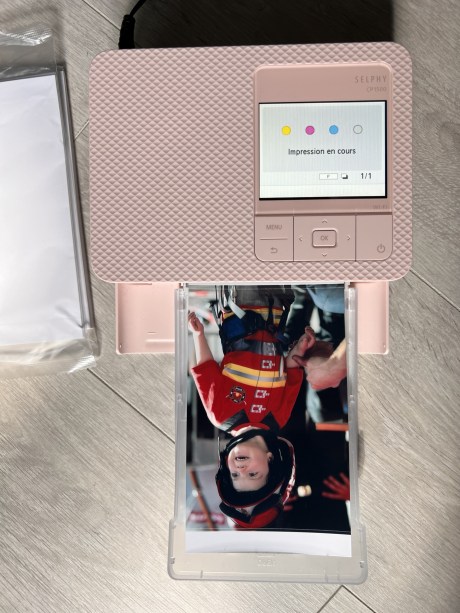
The selection from the printer is a hassle without a name. Going through the integrated SD card reader will require all recorded images to be printed for several reasons. First, the screen quality offers no precision, both in the dynamics of the image and the final rendering. Then the system is too slow. The transition from one photo to another, the time it takes to display several images simultaneously to make a choice, or even the classification will make the experience impossible. This is important to know insofar as the photographer juggles between several cards in professional use and, therefore, quickly accumulates hundreds of images.
We will make up for it by connecting our camera directly and printing via PictBridge. A USB-C port on the side of the printer is for connection. Note that Sony cameras are not compatible.
The 41 seconds it takes to print is both frustrating and remarkable. Remarkable, given the price/quality/format ratio. Frustrating because it’s a long wait of 41 seconds. It will take almost 1h30 to print the 108 photos of the largest pack offered.
Canon Selphy CP1500 Features and Application
The printer’s functionality mostly depends on the Selphy Photo Layout 3.0 smartphone app. An improved version of the questionable Selphy Photo application, which incidentally replaces Canon Print.
Among the options are:
- The possibility of making overlays
- Add patterns
- Choose a layout (Polaroid type, for example)
- For professionals who will make prints during events, you can print a QR code referring to the link of your choice or your logo.
The layouts available are numerous, and there is even a random mode.
In the kingdom of cool things, printing a bookmark consisting of 4 photos is possible.
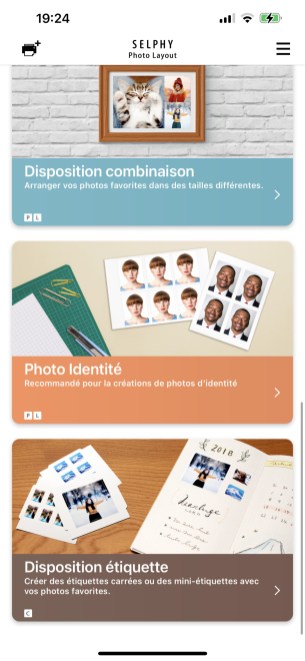
But it is especially the ID photo mode that is practical. The app offers guides for perfect framing. However, the shooting rules must be respected. We realized, for the test, the identity photo was intended for a passport. It was accepted (note: it is not the one in the example below).
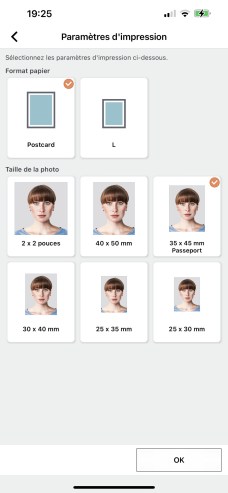
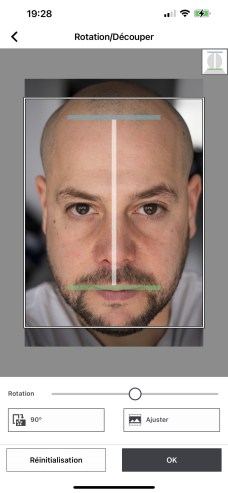
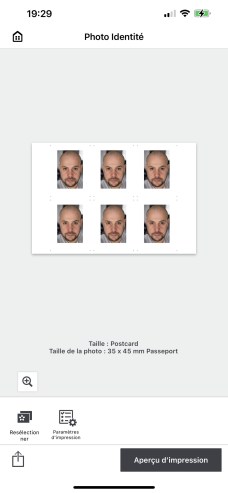
Like its ancestors, the Canon Selphy CP1500 can operate on an optional battery (CP2LI). The set is quite bulky but will fit in a bag. The removable and external battery allows 72 prints. It is enormous.
A side note: many street photographers offer prints to the people they photograph. It’s a great experience for the people in front of the camera and the one who captures them. The CP1500 makes it possible to offer quality printing, inexpensive compared to the price charged by other solutions, and behind which it is possible to note things with a marker, such as your Insta or website. However, you will need a little space and support nearby to place the printer. Things not needed with a Fujifilm Instar printer, for example.
Finally, the ergonomics of the application have been poorly thought out. Searching for a photo is a chore; the recognition of the printer is not always effective, the options are cluttered, and we take no pleasure in using it.
Too bad, because printing from the printer using the screen is no better.
Accessing printing options on the printer directly, such as filters and renderings, is possible. Settings that cannot be made from the application.
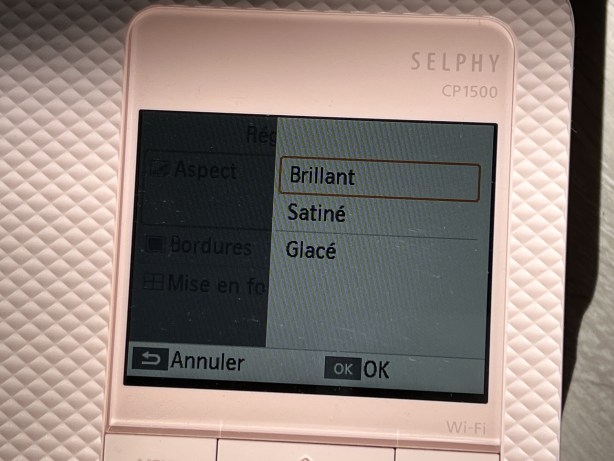
Note: it is possible to configure the printer to launch a print from a PC or a Mac. But the settings are laborious, and the photo is often poorly centered and adapted to the format.
The Selphy CP 1500 is compatible with the PictBridge protocol used by all camera manufacturers – with the notable exception of Sony. Enough to print directly by connecting the camera via USB to the printer.
On the connectivity side, we find everything you can have:
- A USB-C socket
- An SD and microSD card reader via adapter
- Wi-Fi
- Bluetooth
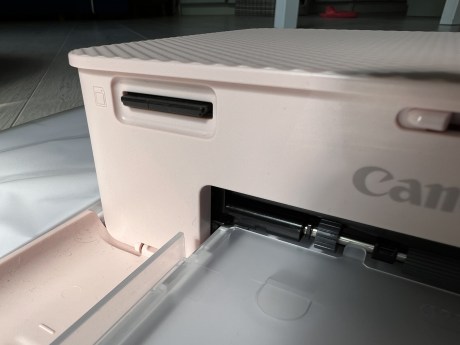
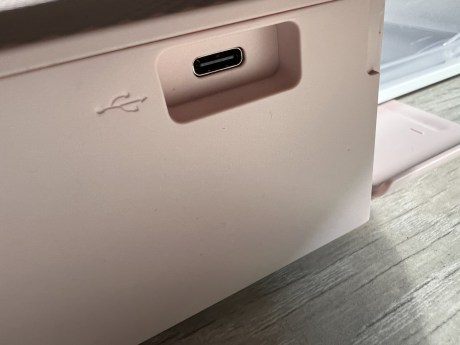
Comparison with other printing solutions
Let’s face it: the Zink impression is bad. The rendering is borderline passable. The colors are garish. The definition is weak. But the worst is the duration over time: in a few months, the colors fade so that after a few years, the photo is no longer even readable; both the colors and the image have faded. A disaster. The price is higher: 0.8 €/photo.
The Fujifilm Instax-like print lacks sharpness and detail. On the other hand, its durability over time is remarkable. The formats are varied, and you can find them everywhere. Subject to agreeing to pay 1 euro per photo.
The gallery above features photos that are several years old. The renderings are excellent, the colors rich, the contrast good. The landscapes were made with an iPhone 13 Pro Max. Some Instax prints are taken with a Panasonic S1R camera.
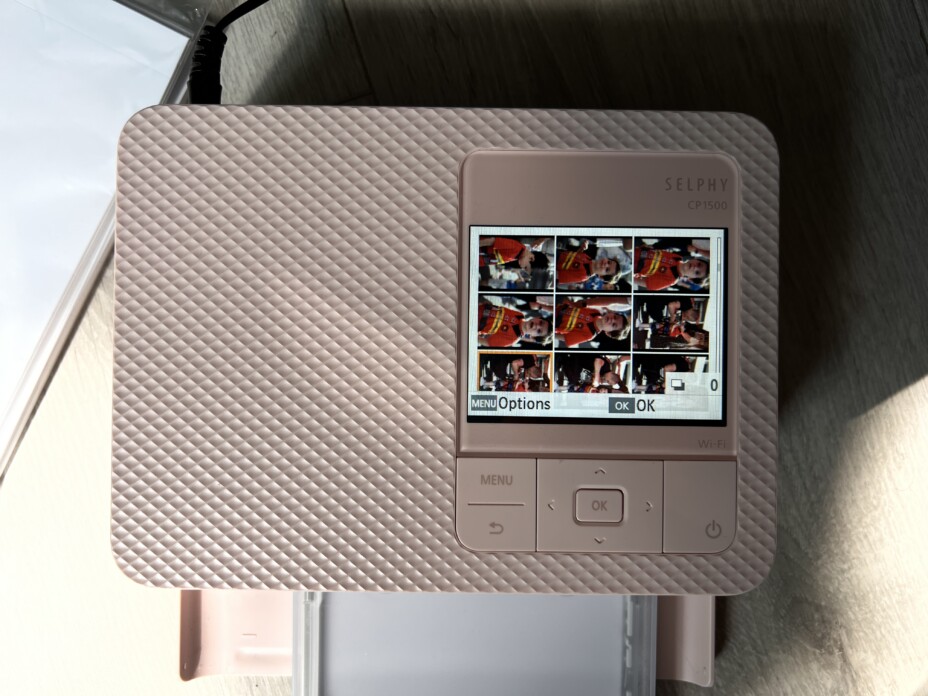
With its €0.36/photo cost, the Canon solution is the most profitable. It is also the best in terms of quality and durability. It is possible to print small photos in credit card format. Easier to transport, they require a printing “ set ” and a cassette of specific sheets sold separately.
The images above mix smartphones, compact and full-frame cameras. The rendering is excellent, both in black and white and in color, regardless of the source. The print of the landscape is almost a decade old, and the colors have not faded, with a rendering that is still as detailed as ever.
The evolutions of the Canon Selphy CP1500 vs CP1300
Between the new CP1500 and the old CP1300, the evolutions are not incredible:
- Print time is 41s vs. 47s
- The AC adapter is a bit more compact
- The screen is no longer orientable (too bad for printing from an SD card, but so much the better since it was the weak point of the previous model)
- The CP2LI external battery allows you to make 72 prints against 54 previously
- A new finish for a satin finish is available
If you own a Selphy CP1300, 1200, or even 900, upgrading to the CP1500 is unnecessary. You won’t gain any image quality, with the same printing system.
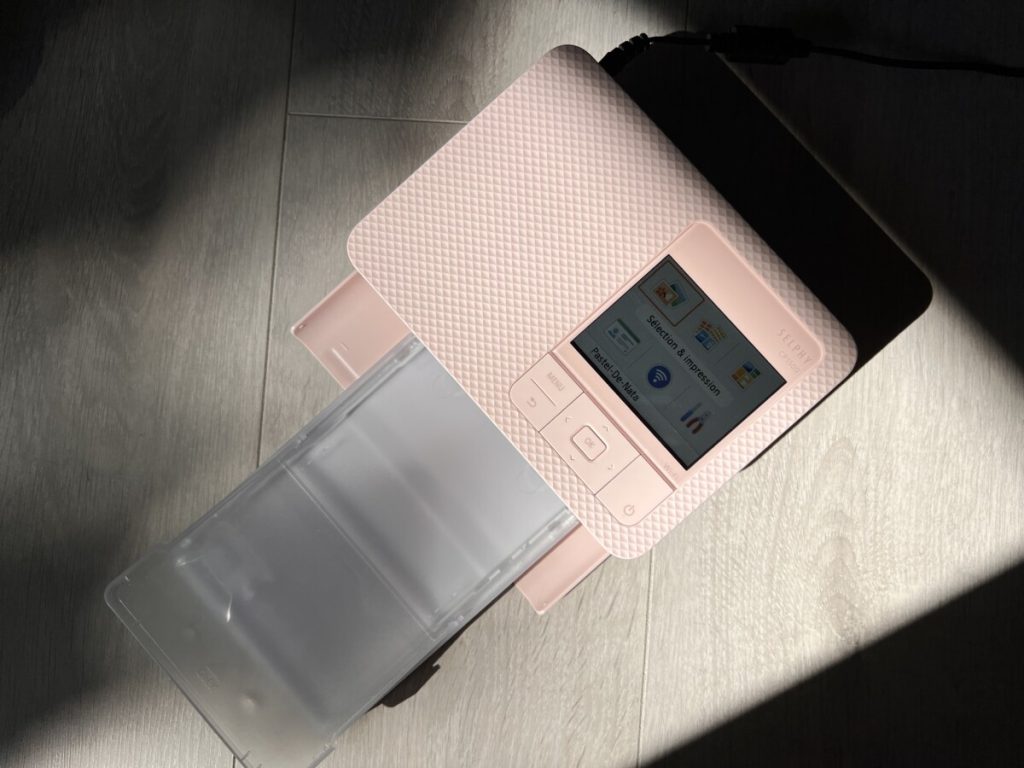
The Canon Selphy CP1500, for what purpose?
Here is THE complicated question of this test. We think first of all of the photographers. The pleasure of offering a print or making a work concrete is enjoyable. But photographers will opt for a lab and larger formats for their prints and portfolios. There is also a frustration between the rendering of the image and the quality that current photo tools can provide.
The little family is having fun and sticking pictures on the fridge. You quickly reach the space limit unless you have dozens of huge fridges. Albums of photos printed directly have replaced albums containing photos. They offer better quality for a price often lower than the print alone.
Users looking for fun don’t need such image quality. On the other hand, compactness is paramount, as is the efficiency of the application. Two points to which Canon does not respond, but the competition does (Canon also via another range called Zoémini, but with a not very famous reputation and using this famous bad Zink paper).
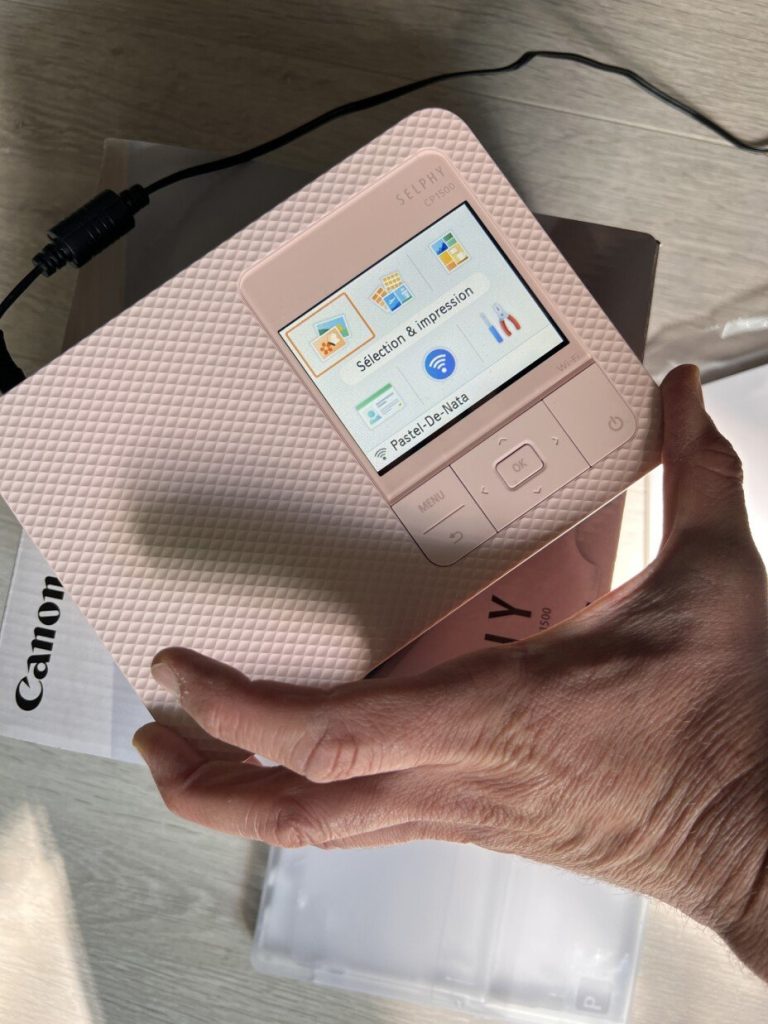
Although I am a long-time user, I must admit that this system seems to date from another age. Today’s printing solutions, especially via smartphone applications, offer much more for less. The more compact solutions ensure when it is necessary to print immediately. Compactness takes precedence over quality. On this point, Fujifilm, with its Instax, offers a more significant solution.
The product remains good at what it does, which is to print. The finish is very good, and the design is nice. The versatility offered by the optional external battery isn’t bad. But everything around it, from the app to the volume of the gear, nothing is going the right way. Too bad because Canon has an interesting product. But after almost two decades of marketing, we are entitled to expect a mature product.
To be reserved for fans of photos in a hurry who are looking for quality and believe that the price (admittedly prohibitive) of Instar and the mediocre quality of Zink paper are not valid solutions.
Canon Selphy CP1500 price and availability
The Canon Selphy CP1500 photo printer has been available since September 2022. It is available in three colors – black, pink or white – for 139.99 euros.
Conclusion
Quality compact home printing solutions are not commonplace. The Canon CP1500 does not revolutionize either the genre or the range. The time saving is anecdotal, intrinsic to the thermal sublimation technology used. Noise is inherent in this kind of impression. The volume of the printer is substantial, despite the desire to make the object more compact. This is the price to pay for high-quality photos far superior to other printing technologies.
Better print quality, richer colors, and more detailed renderings. But the icing on the ink ribbon is the durability of dye sublimation. Canon advertises that the prints last 100 years. Without going so far, we have pictures taken with Selphy CP, which is 20 years old and have not moved.
On the other hand, we will rail against the Selphy Photo application, which manages to be less effective than the old, still functional Canon Print application. Nothing works, and printing from this app is a hassle, whether to establish a connection or find a photo that goes up a little in your library.
We regret the printer interface, which does not help to access photos from an SD card quickly. You then have to deal with a slow system that struggles to display barely visible thumbnails because of the screen’s too-low definition. A screen with poorly calibrated colors and no histogram.
However, besides the quality of the prints, there is the lowest printing cost in the compact printer market. Less than 0.3€ per photo, that’s 3 times less than an Instax print, which is nevertheless smaller and much less qualitative.
It remains to be seen whether faced with the many efficient and affordable service providers accessible via applications, this type of printer will still succeed in seducing.
POSITIVES
- Print quality is better than the competition
- Convenient and usable ID Photo function
- Lowest printing cost in the mini printer market
- Compatible with Apple and Android printing shortcuts
- The optional removable battery provides approximately 72 prints per charge.
CONS
- Poor screen display quality
- Low-quality non-tilting screen (dynamic, color)
- Finding photos from the printer on an SD card is mission impossible
- Badly done application, which crashes a lot
- Printing noise can bother
